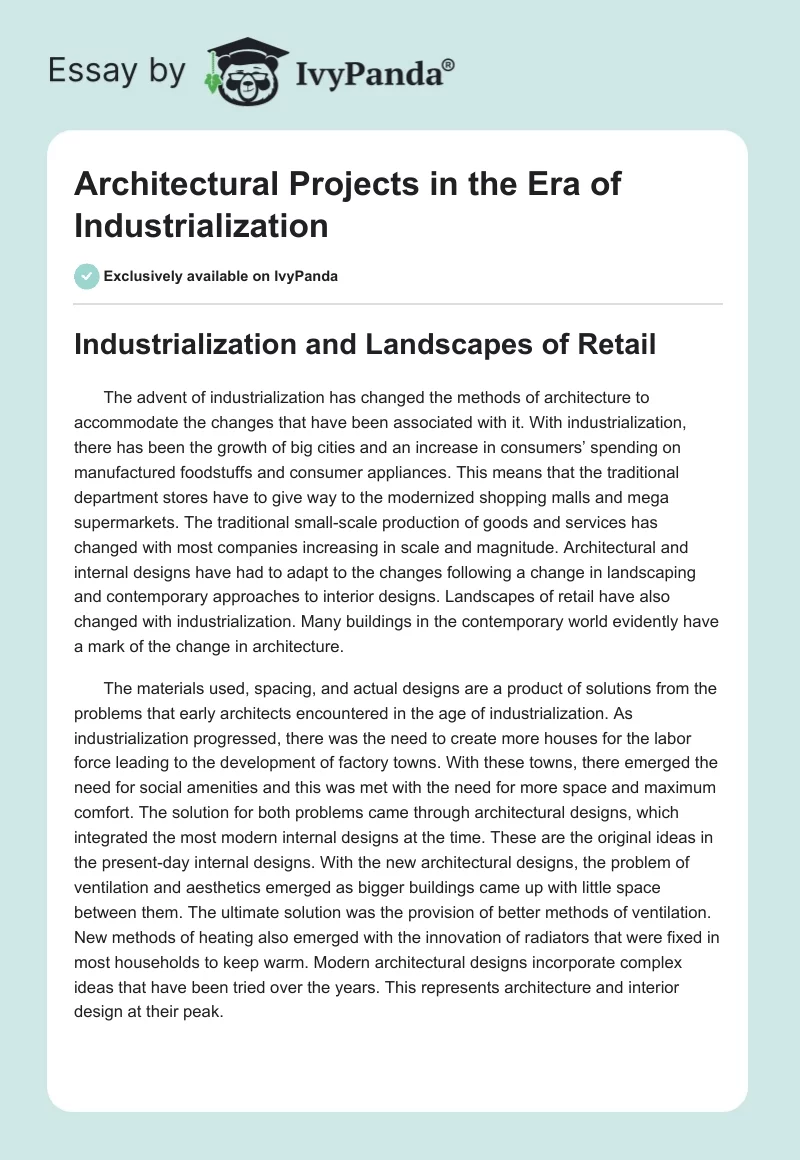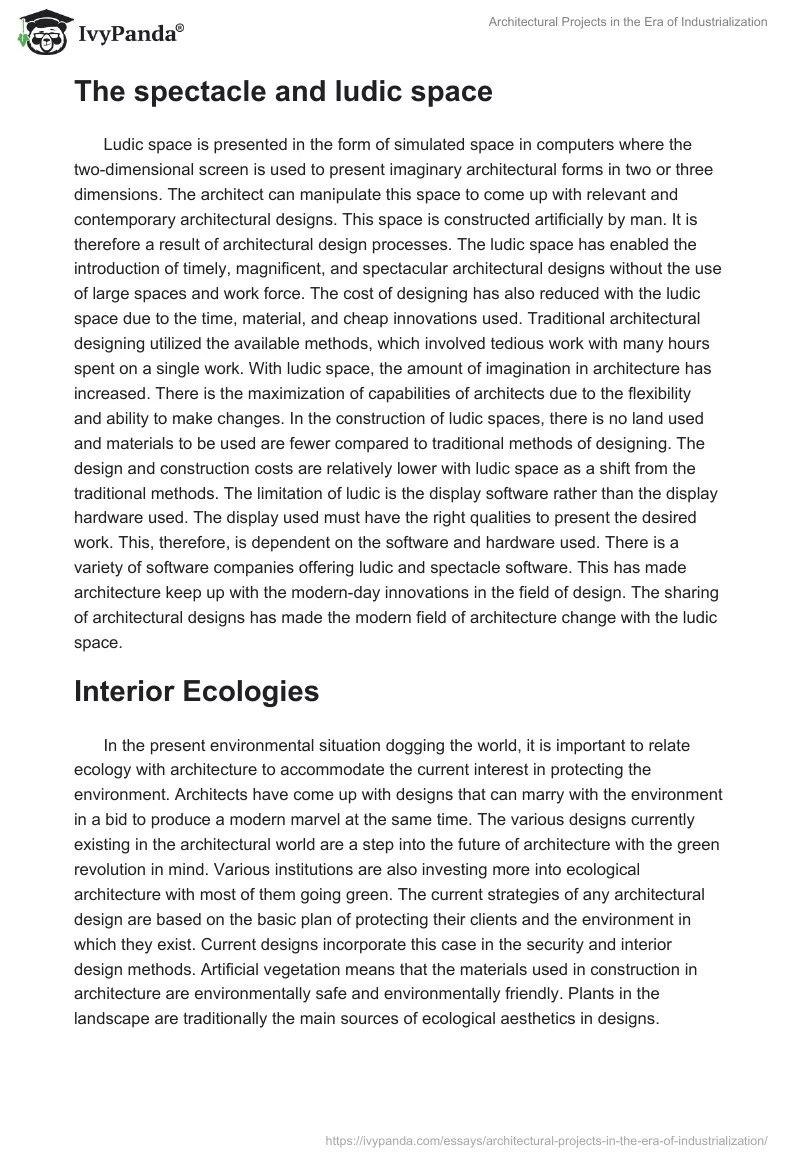Industrialization and Landscapes of Retail
The advent of industrialization has changed the methods of architecture to accommodate the changes that have been associated with it. With industrialization, there has been the growth of big cities and an increase in consumers’ spending on manufactured foodstuffs and consumer appliances. This means that the traditional department stores have to give way to the modernized shopping malls and mega supermarkets. The traditional small-scale production of goods and services has changed with most companies increasing in scale and magnitude. Architectural and internal designs have had to adapt to the changes following a change in landscaping and contemporary approaches to interior designs. Landscapes of retail have also changed with industrialization. Many buildings in the contemporary world evidently have a mark of the change in architecture.
The materials used, spacing, and actual designs are a product of solutions from the problems that early architects encountered in the age of industrialization. As industrialization progressed, there was the need to create more houses for the labor force leading to the development of factory towns. With these towns, there emerged the need for social amenities and this was met with the need for more space and maximum comfort. The solution for both problems came through architectural designs, which integrated the most modern internal designs at the time. These are the original ideas in the present-day internal designs. With the new architectural designs, the problem of ventilation and aesthetics emerged as bigger buildings came up with little space between them. The ultimate solution was the provision of better methods of ventilation. New methods of heating also emerged with the innovation of radiators that were fixed in most households to keep warm. Modern architectural designs incorporate complex ideas that have been tried over the years. This represents architecture and interior design at their peak.
The spectacle and ludic space
Ludic space is presented in the form of simulated space in computers where the two-dimensional screen is used to present imaginary architectural forms in two or three dimensions. The architect can manipulate this space to come up with relevant and contemporary architectural designs. This space is constructed artificially by man. It is therefore a result of architectural design processes. The ludic space has enabled the introduction of timely, magnificent, and spectacular architectural designs without the use of large spaces and work force. The cost of designing has also reduced with the ludic space due to the time, material, and cheap innovations used. Traditional architectural designing utilized the available methods, which involved tedious work with many hours spent on a single work. With ludic space, the amount of imagination in architecture has increased. There is the maximization of capabilities of architects due to the flexibility and ability to make changes. In the construction of ludic spaces, there is no land used and materials to be used are fewer compared to traditional methods of designing. The design and construction costs are relatively lower with ludic space as a shift from the traditional methods. The limitation of ludic is the display software rather than the display hardware used. The display used must have the right qualities to present the desired work. This, therefore, is dependent on the software and hardware used. There is a variety of software companies offering ludic and spectacle software. This has made architecture keep up with the modern-day innovations in the field of design. The sharing of architectural designs has made the modern field of architecture change with the ludic space.
Interior Ecologies
In the present environmental situation dogging the world, it is important to relate ecology with architecture to accommodate the current interest in protecting the environment. Architects have come up with designs that can marry with the environment in a bid to produce a modern marvel at the same time. The various designs currently existing in the architectural world are a step into the future of architecture with the green revolution in mind. Various institutions are also investing more into ecological architecture with most of them going green. The current strategies of any architectural design are based on the basic plan of protecting their clients and the environment in which they exist. Current designs incorporate this case in the security and interior design methods. Artificial vegetation means that the materials used in construction in architecture are environmentally safe and environmentally friendly. Plants in the landscape are traditionally the main sources of ecological aesthetics in designs.
The modern architecture uses interior designs combined with ecological plants to replace the traditional approach. A wide range of options is available for architects in creating the expected ecological environment. Space is critical in the current planning methods in architecture. Therefore, most of the space available is interior to the designs. Most of the malls and large buildings in cities and towns have fountains integrated into their architectural designs with some hosting modernized methods of thermoregulation and air conditioning. The best example is the mall where large open spaces with sunroofs enable plants to thrive with adequate room for them. The open space also mimics the external environment with scenic surroundings. This seems to be a big step forward in the field of architecture and interior ecologies.
Globalization and Generic Space
With globalization, architecture has changed significantly to accommodate the changes. There are various emerging methods of space utilization to counter the challenges of globalization, which include reduced space for the construction. Generic space provides an option for space utilization in the current dispensation for architects. Ambitious projects are underway in many cities exploring the generic space with China and the United Arab Emirates leading the pack. Dubai is a good example of modernized cities utilizing generic space. Various architectural designs have been unveiled demonstrating this concept. With globalization, the exchange of ideas has been swift with most countries encouraging competition between foreign-based architects together with those of their home countries. This has led to innovation in the field of architecture. The generic space is one of these manifestations. A generic space is virtually developed with its main function being to change the modern-day architectural landscape. It provides an option for architects. New structures are now marking popular sites all around the world. Globalization has allowed equity in the availability of designs to all regions of the world without distinction of culture, time, and tradition. This has broken the barrier to cooperation and standardization. There are various ways in which globalization has changed the generic space with the above listed being the most significant. The United States is leading in the application of generic space. Art is catching up with the rest of the world. More than a quarter of the designs and implemented projects find their home here with Singapore, Dubai, China, and Japan closely following. This step into the future of architecture continues to provide more options for architects.
Architecture of Surveillance
The present-day buildings and structures are set up with the aim of protecting any forces, which may prove destructive to inhabitants and the building itself. Architecture therefore must provide surveillance in preventing these disasters and incidents. Traditionally, surveillance has been used as a power symbol and an efficient method of controlling people. Currently, it is used to express and demonstrate security and safety in towns and cities. The surveillance has increased since the attack on the United States that happened on September the eleventh 2011. This has seen the option of closed-circuit televisions being incorporated in almost every building and landmark around. Every architect must incorporate surveillance tools in his/her ideas to provide a selling design. The use of surveillance has however elicited controversy with opponents claiming that it is a violation of privacy for them.
Proponents claim that there is improved security with these surveillance measures. In the surveillance methods available, architects choose to incorporate them in the original designs or have them installed later. Other methods of surveillance are continually being tried into contemporary buildings with the view of linking them and providing a network of communication between proprietors and their architectural designs. In the architecture of surveillance, consideration must be made on the risk of an architectural design, the risk likely to target it, and the best way of preventing the risk. Surveillance has been criticized as reacting to threats rather than preventing them. However, this can change with improved surveillance allowing rapid response and predicting the threats. The best architectural design is one that is flexible enough to allow surveillance as desired by the clients.
Simulacra and Themed Space
Simulacrum involves the formulation of a work of art that is of a lower substance or quality than the actual or original work. A simulacrum is therefore the simulation of an architectural work that resembles the final product with the two not being exactly alike. One can take a photo of the original product and use it to produce simulacra drawn from the photograph. A painting can be created from a photograph taken of the desired work of art. An example of simulacrum is caricature where an architectural artist draws a line approximating a particular object with one part being the drawing and the other a real one. Although the drawing closely resembles the real object, there is a distinct difference between the two. However, the object can be used to identify the object. The application of themes in spaces is catching up in modern architectural designs with most of the architectural works fitting a certain predefined theme. The design in most households, offices and work environments is suited for the functionality and choice of the client involved. The choice of themes depends on the existing technologies, colors, and the various techniques available. Currently, clients get to choose from a variety of themes with advice from experts in interior design and architects themselves. In the world of architecture, limitless interior and exterior designs are present. These can be computer-generated or as envisioned by designers in the field of architecture. Solid structures can be made to look friendly and appealing to the human eye by the application of simulacra and themed space. Modern architecture has fully explored this possibility to come up with magnificent structures, which stand the test of time.
Cyberspace
Cyberspace has grown to incorporate large independent internet infrastructures. This has revolutionized the modern teaching and practice of architecture and interior design. Cyberspace has influenced the practice of architecture in various ways. Since the world has grown into a global village, cyberspace has allowed the interaction of architects around the world with the sharing of design ideas and projects being easier. With the development of cyberspace and the improvement of information infrastructure, unlimited designs have been made. An architect can get inspiration through other works of art by people in cyberspace. However, there is the risk of ideas being lost and stolen in cyberspace with the interaction that comes with it. Information sharing on internal design has enabled a rather fast progression of this field of architecture to a sophisticated level. This happens partially due to the rate at which cyberspace has improved and made working for architecture easily. A software design company developed a system for virtual design in late 1989 and called it cyberspace. This has been used in the making of two-dimensional and three-dimensional designs applied in architecture. After the development of the design, the architect only must transfer it to saved memory for sharing or implementation on projects. This can only be possible in the current trends in information technology, which have revolutionized architecture and interior designs. Cyberspace is therefore a necessary tool in the current day practice of architecture. Cybercriminals pose a significant threat to cyberspace through attacks on networks and information sharing infrastructure. However, this challenge is countered by the various existing regulations and laws on cybercrime. Cyberspace, therefore, remains an important area of interaction between technology and architecture.


